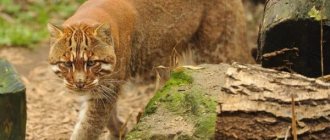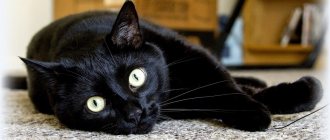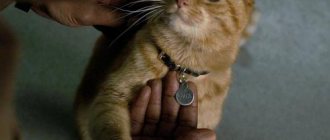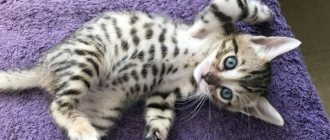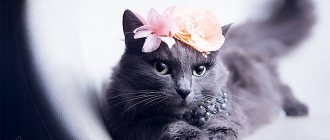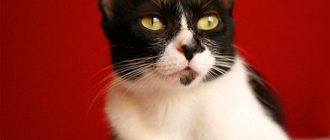Relatives of domestic cats are quite numerous: the existing classification notes the existence of 41 species of representatives of this family. Most of these animals are similar to each other, distinguished by their beauty and noble habits, although some wild relatives of domestic purrs stand out from the general crowd. Large and small cats, among which there are rare and endangered animals, are predators. At the same time, any of the predatory animals on our planet falls into the category of canines or cats. The latter, in addition to large and small cats, include the families of hyenas, civets, mongooses, Asian linsangs, and palm civets.
History of origin and habitat
The first relatives of modern cats formed at the initial stage of the current geological era (Cenozoic). More than 50 million years have passed since then. Scientists say that the familiar appearance of wild representatives of the cat family was formed after the end of the glaciation period. These predators turned out to be one of the lucky few who managed to survive the increase in average annual temperatures. For most other animals with dense, thick fur, the new warm climate of the Earth turned out to be too hot.
The appearance of individual specimens (manul cat) has remained the same since then, other animals have changed greatly in the process of evolution, but have retained the distinctive features of the cat family.
The ancestor of modern predators, miacids, was small in size and had a long tail. In the Oligocene era (about 30 million years ago), these carnivorous animals took a dominant position on the planet.
The extinct predator Proailurus, which most scientists consider the ancestor of small and large cats, spread across the planet 25 million years before the present. This 9-kilogram animal is very similar to the current inhabitant of the island. Madagascar - fossu. About 18.5 million years ago, Proailurus evolved into Pseudelurus. These animals, which first appeared in Eurasia 7 million years ago, entered North America. Of the modern mammals, Pseudalurus most closely resembles African linsangs.
Pseudaelurus was the ancestor of three types of cats: small, large, saber-toothed. Huge saber-toothed mahairods arose 15 million years ago, died out 2 million years ago, leaving no descendants.
Nowadays, predatory relatives of domestic cats are widespread throughout the planet, primarily in warm climate zones. You can’t meet these elegant, flexible hunters only in the snowy expanses of Antarctica and Greenland, Australia and Madagascar. In temperate climates, wild cats are not as widely represented as near the equator or in the tropics. The taiga zone provides shelter only for certain species: lynx, puma, tiger, wild forest cat. But domesticated fluffies amaze with the variety of breeds and are found in all parts of the globe.
The first domestic purrs appeared 7-10 thousand years ago. The cats of Ancient Egypt, deified by man, are well known. Today, many representatives of wild cats have to fight for existence. Modern people have realized the need to preserve the diversity of the Earth's fauna by adopting the necessary international laws to protect flora and fauna.
irbis-mihail_semenov.jpg
Snow leopard.
Photo: Mikhail Semenov In 2010, the Russian Geographical Society supported the grant project “In the Footsteps of the Snow Leopard.” Its goal is to study the state of the snow leopard population, its numbers and age-sex structure, as well as key habitats. These data will help solve the problem of optimizing the territorial protection of this species, as well as the ecosystems of Southern Siberia as a whole. In 2012, the project “In the Footsteps of the Snow Leopard” grew into a full-scale project “Wild Cats of Southern Siberia” to study and preserve rare species of cats in the south of Siberia - snow leopard, manula and lynx.
Manul
The Pallas's cat is a predatory mammal of the cat family, one of the least studied wild cats in the world. Pallas's cat is widespread in Central and Middle Asia, from Southern Transcaucasia and Western Iran to Transbaikalia, Mongolia and Northwestern China. Within Russia, Pallas's cat is found in the Chita region, Buryatia, Tuva and Altai. Included in the Red Books of the Russian Federation, the Trans-Baikal Territory, as well as the republics of Tyva and Buryatia. Manuls can be seen in the Sayano-Shushensky, Khakassky, Daursky nature reserves. The exact number of the species is unknown due to the secretive behavior of the Pallas's cat and the patchy nature of its distribution. Pallas's cat is listed in the Red Book of the Russian Federation, the IUCN Red List and Appendix II of the CITES Convention.
Characteristic
The cat family (Felidae) includes mammalian predators with common characteristic features: lifestyle, type of nutrition and reproduction, morphology, hunting habits.
Morphology
The sizes of representatives of the cat family range from 30 cm to 4 m, body weight - from 1 kg to 300 kg. Males differ from females in their greater mass, impressive dimensions and additional external features (lion's mane). The largest in the family are lions and tigers, the smallest are black-footed and spotted cats.
Paw structure: 5 toes on the front paws, 4 toes on the hind feet. Sharp claws tend to hide under the paw pads. Cheetahs, as well as Sumatrans, do not possess the latter quality.
Number of teeth: 28-30. This is much less than other known predators. This corresponds to the specific structure of the head: a rounded skull with a short muzzle. With a small number of teeth, effectiveness is achieved by a strong bite. The long, cone-shaped fangs easily tear through the flesh of prey with minimal jaw force. The teeth located behind the cheeks are used to tear pieces of meat from the victim’s body.
The rough tongue is used to lick the remaining meat from the bones of prey and to keep the skin clean.
Long tail, sometimes with a tassel at the end.
The coat is most often short and thick, although differences in density and length are possible depending on the climatic zone of the habitat.
The color palette of the skin varies from brown to gray. Types of colors: plain, spotted, patterned, striped. There are entirely black individuals or (much less often) albinos. The animal's color may change as it grows. For example, lion or puma cubs are covered in spots, while adults have a solid color. The back and outer surface of the limbs are darker than other areas. The animal's muzzle, forehead and tail usually have markings in the form of spots or lines.
Lifestyle
All cats are characterized by excellent functioning of the organs of vision, an expanded range of perception of sounds, up to ultrasonic frequencies. The sense of smell is also good, but in terms of sensitivity it lags slightly behind the two primary indicators.
These animals usually show maximum activity in the dark. Night time is for hunting, day time is for rest.
Lifestyle – solitary or gregarious. At the head of the pack (pride) is a strong aggressive male, who directs the entire life of the community.
A distinctive feature is to make specific sounds (purring). Small cats can purr while inhaling and exhaling, but large cats can only purr while exhaling. Other sounds: roar, hiss, scream, meow. Loud roars are the privilege of large predators. The structure of the hyoid bone does not allow small cats to roar.
Members of the cat family owe their silent movement and the ability to make quick, easy jumps to their toe-based gait.
The process of tracking the victim is simplified thanks to an additional mirror layer on the iris of the eye. This feature allows furry hunters to examine objects at night. In low light, a cat sees 7 times better than a human.
The vertical modification of the pupil provides the predator with a wide view, and the width of the slit is adjusted depending on the light level.
Equipped with muscles, the ears can easily change their geometry, creating a three-dimensional picture of the surrounding world thanks to signals coming from different directions.
Vibrissae, which are commonly called whiskers, are an organ of the “sixth sense” that sends signals to the brain perceived from the environment. Sensors on the paw pads provide information about humidity, atmospheric pressure, and temperature.
An additional olfactory receptor is designed to recognize individuals of the opposite sex.
With rare exceptions, relatives of cats move freely on vertical surfaces and climb to great heights.
The internal etiquette of relationships requires caution and the exchange of signals indicating mood. Unbridled aggression is not the norm of communication.
Like other predators, relatives of cats mark their habitat by secreting a liquid with a specific odor and leaving marks with the help of their claws.
Reproduction
Representatives of cats are distinguished by polygamy. The head of the pack mates with all the females of the pride, so most members of the pack are blood relatives. A wide variety of genes and little competition between males ensure the survival of the young. The season of readiness for mating in females lasts 1-20 days and resumes until fertilization occurs. During the period of estrus, the female calls her partner with special signals and marks the places near the mating area with an odorous liquid.
Competition between male specimens for the attention of a female is expressed in fights, signs of attention, and poses expressing submissiveness (bowed head). The duration of coitus is less than a minute, the act is repeated many times until the girlfriend becomes pregnant. At the end of estrus, the male sets out in search of a new passion.
For animals living in cold zones, the mating season coincides with the warm season.
Small pussies give birth 2-3 times a year, large ones - once every 18 months. Newborn babies are not adapted to independent living and feeding; their visual organs open some time after birth. The mother usually raises the offspring, but for some species nature made an exception and allowed the fathers to also take care of the children. The interval between births depends on several parameters: the rate at which the babies grow up, their size, and the amount of food available in the region where they live. If the litter dies, the female is again ready for mating after 10-20 days.
The number of babies in a litter ranges from 2-4 to 8-10. Small females are ready for pregnancy by the end of the first year of life, carry the cubs for 2 months and keep the offspring breastfed for a month. Large predators learn the joy of motherhood at the age of 3-4 years, carry babies in their wombs for 3 months, and teach their children to solid food 3 months after birth.
Life span is from 10 to 30 years. Minor kittens are exposed to many dangers: death from predatory animals, developmental defects, mother's refusal to feed, cannibalism.
Nutrition
Predatory cats living in the wild feed almost exclusively on meat obtained by hunting. Carrion is rarely of interest to these animals. The diet includes a small amount of herbs to cleanse the stomach of poorly digestible foods. Residents of hot countries add fruit and vegetable desserts to the menu to restore water balance in the body.
Large animals prefer to feed on ungulates, while small animals prefer to eat rodents, birds, and sometimes fish and amphibians.
Unlike cat cubs, other animals are not dangerous to adult predators. Some animals suffer from infection with ecto- and endoparasites (worms, lice, ticks, etc.)
dalnevostochnyy_leopard_-_mihail_kolesnikov.jpg
Far Eastern leopard.
Photo: Mikhail Kolesnikov Since 2011, the Russian Geographical Society has supported the Far Eastern Leopard project. Its goal is to study the state of predator populations, as well as develop the infrastructure of specially protected natural areas within its range.
In order to preserve the unique natural territories of Russia where the Far Eastern leopard lives, and thus save this subspecies, an autonomous non-profit organization “Far Eastern Leopards” was established in 2011. It cooperates with the Leopardovy Nature Reserve, the Kedrovaya Pad Nature Reserve and the Land of the Leopard National Park, created in 2012.
Irbis, or snow leopard
The snow leopard, or snow leopard, is the only species of the snow leopard genus and the only large representative of the cat family that lives in the highlands of Central Asia. The habitat of the snow leopard lies in the upper and middle zone of the mountains of Central and Central Asia (Himalayas) and Southern Siberia. This range includes the territories of Russia, Afghanistan, Burma, Bhutan, India, Kazakhstan, China, Kyrgyzstan, Mongolia, Nepal, Pakistan, Tajikistan and Uzbekistan. The species is endangered. According to various estimates, about 7 thousand snow leopards live in the wild, while in Russia there are only 150–200 individuals. In the Red Book of the Russian Federation, the snow leopard belongs to category I. This predator is also listed in the Red List of the International Union for Conservation of Nature and in Appendix I of the Convention on International Trade in Endangered Species of Wild Fauna and Flora (CITES). In 2011, the state nature reserve of federal significance “Pozarym” was created, on the territory of which the reintroduction of young snow leopards is carried out.
Genetic classification
Genetic analysis has added new possibilities to the traditional classification based on morphological characteristics, making it possible to rank cats into 8 groups:
- Lions, Tigers and Clouded Leopards, united under the name Panthers.
- A combination of Katopum and Marble cats called Kalimantan cats.
- Caracals.
- Ocelots (8 South American species).
- Lynxes.
- Cougars and Cheetahs under the name Puma.
- Asian species + Pallas's cat are included in the Bengal group.
- Homemade.
manul-evgeniy-mazurin.jpg
Manul. Photo: Evgeny Mazurin
Lynx
Lynx is a genus of predatory mammals of the cat family, closest to the genus of cats. It lives in Russia, Scandinavia, Finland, some areas of Poland and the Czech Republic, as well as in Spain. In Russia it is found in dense, overmature coniferous forests from the western borders up to Kamchatka and Sakhalin. The lynx is included in Appendix I of the Convention on International Trade in Endangered Species of Wild Fauna and Flora (CITES) and in the list of endangered animals of the international Berne Convention. This rare, endangered species is also present in the Red Data Books of Belarus, Kazakhstan and 17 constituent entities of the Russian Federation.
What is the biggest cat in the world?
Background The tiger is the largest and heaviest of the wild cats, but its various subspecies vary greatly in size and body weight. Mainland tiger subspecies are larger than island ones.
Interesting materials:
How to multiply numbers with different powers? How to multiply two numbers with different powers? How to convert a number to a date? How to convert a number to natural logarithm? How to convert a negative number to a positive number in Excel? How to convert percentages to numbers and vice versa? How to divide all numbers in Excel? How to count the number of numbers in a range in Excel? How to get an even number? How do you know until what date the product is good for?
Nutrition
Based on morphological characteristics, felids are considered the most specialized predators of all carnivores. They are at the top of the food chain in most ecosystems as their diet consists almost entirely of animals. Sometimes cats will ingest grass, which helps to "cleanse" the stomach of indigestible foods such as hair, bones and feathers. Some species consume fruit to compensate for the lack of water. Felids can eat viscera (i.e. internal organs) of prey, thus consuming partially digested plant biomass. Although big cats typically hunt large prey (such as equids and artiodactyls), they also occasionally feed on carrion. Small cats mainly hunt rodents, rabbits or hares. Whenever possible, small cats feed on reptiles, amphibians, birds, fish, crustaceans and arthropods. Some species hide their prey and may drag killed carcasses under nearby trees before consuming them (for example, the leopard). Fishing cats and Sumatran cats are unique among felids in that they have adapted to hunt fish and frogs.
Description
All cats bear a strong resemblance to each other. Unlike members of the canid family (Canidae), felines have short mouths and a characteristic dental formula, which increases their bite force. The loss or reduction of premolars and molars is especially evident in felines, which have a typical dental formula of 3/3, 1/1, 3/2, 1/1 = 30. In most species, the upper premolar is significantly reduced, and in lynxes (Lynx), completely absent. Felines have well-developed carnassial teeth. Their cheek teeth are tuberculate and specialized for cutting meat. The fangs are typically long and tapered, and are ideal for piercing the tissues of prey with minimal force. Cats also have a vestigial baculum and retractable claws. Most cats have five toes on their front paws and four on their back paws.
Body weight varies from 2 kg in black-footed cats (Felis negripes) to 300 kg in tigers (Panthera tigris), and there is sexual dimorphism, with males being larger and more powerful than females. In some species, such as lions (Panthera leo), males may also have ornamentation that is used to attract potential mates. Throughout the range, cats' coats are longer where environmental temperatures tend to be low (such as snow leopards). Felids display a wide range of coat colors from black to white, and many species possess cryptically colored coats containing rosettes, spots and stripes that help camouflage the animals when hunting. Melanistic variants (solid black) are common in many species, but all-white individuals tend to be rare. Large changes in coat color can occur within individual species and ages. For example, adult pumas (Puma concolor) rarely have spots, while their kittens almost always have them. In general, cats' bellies are usually light in color, and the face, tail, and back of the ears often have black or white markings.
Felids have a number of morphological adaptations that have allowed them to become the most skilled hunters among carnivores. They are digitigrade, which allows them to move quickly. Their powerful limbs help them capture and hold large prey. Often, cats have a mysterious camouflage that makes them invisible while hunting. Additionally, many felines have large eyes and exceptional vision. In nocturnal species, the tapetum helps capture limited light. Most species are famous for their large, slightly structured, rotating ears. And finally, their tongue has a sandy-texture, which helps keep food in their mouths and separate meat from the bones of prey.
Australian smoke
Animals of such breeds appeared in Australia by crossing the Abyssinian and Burmese breeds. The coat color consists of several shades, it can be peach, lilac and even blue. The eyes are almond-shaped and the coat is short. They only have green eyes. The body is medium in size and the neck is small. The ears are large, gradually tapering, and slightly curled at the edges.
“Spotted cats are perfect for families with small children. When they play with children, they don’t use their claws, their character is sincere and calm.”
Spotted cat breeds are very intelligent creatures and can make wonderful company for their owner. They are not capricious and are easy to learn at home. In order for your pet to love you and treat you well, it is enough to surround him with love and try to forgive him his little pranks.
Spotted cats are simply magnificent, they are one hundred percent suitable for keeping in the house. If you treat them well, they will reciprocate your feelings.


